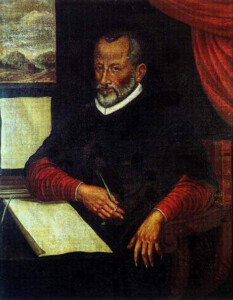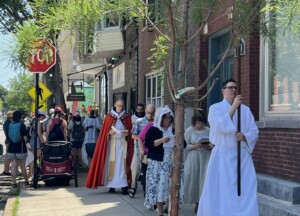Today, as we celebrate the anniversary of the Dedication of the Lateran Basilica, it seems like a good moment to reflect on the subject of ecclesiology. Ecclesiology means the study of the ecclesia, the Church.
What is the Church? What does it mean to be a member of the Church? These questions are not as easy to answer as we might think at first blush.
For example, when we ask what the Church is, the answers that we get from theologians vary, depending on the perspective from which we view the Church. It is the mystical Body of Christ. It is the sacrament of salvation for the world. It is the People of God, or the Perfect Society, through which we, the members, receive grace and are sanctified and perfected in union with our shepherds, the bishops, under the special care of the Holy Father, Christ’s vicar on earth. And of course, any one of these “models” is itself a mystery, and therefore open to ongoing reflection.
I would like to offer the idea of the Church as a kind of fractal, just to make things at first even more mysterious and perhaps overly complicated.
What is a fractal? In certain popular usages of the term, it refers to a shape that is made up of several connected versions of the same shape on a smaller level. Imagine, for example, a snowflake, with it six points. Now imagine taking six of the same snowflakes and connecting them around a center so that it makes a new hexagonal snowflake. And imagine that this new snowflake has the same shape as each of the six smaller snowflakes. That’s what I mean by fractal in the case. As we zoom our or zoom in, we see the same shape emerge each time. That shape is repeated at different levels.
So, there is one Church, as we say in the Creed. That is because Christ Himself is the One mediator between God and Man, and the Church is His Body and His Bride. There can only be one Bride for Christ and that is the Church.
Now, a brief side note on the Lateran Basilica. Just over two thousand years ago, in the City of Rome, there was a family that had recently become a part of the wealthy class in pagan Rome, and their name was the Lateran family. They built a palace on the site of what is today the Lateran Basilica. This palace was confiscated by the Emperor Nero and became part of the government’s property. Three hundred years later, when the Emperor Constantine became Christian, he donated that former palace to the pope at the time, Pope Miltiades, and it became the seat of the bishop of Rome. The building was destroyed several times, and the current building was built over the course of the sixteenth and seventeenth centuries. In the fourteenth centuries, the building was destroyed by two fires while the pope had moved his administration to the city of Avignon in France. When Saint Catherine of Siena persuaded Pope Gregory XI to return to Rome, he found the Lateran Basilica completely in ruins. So he moved his administration to Saint Peter’s Basilica on the Vatican hill, and this is where the pope continues to exercise his governance of the Church. However, the Lateran remains the cathedral church of Rome, and therefore is the Mother Church of the entire Roman Catholic world. Hence our celebration today. It is a sign of the unity of the Church under one pope, and a sign of the Incarnation, inasmuch as there can be only one Mother cathedral, and for God’s purposes, He chose Rome to be the home of this church.
Now, let’s return to the idea of a fractal. So, you remember that I said that when either zoom in or zoom out, we see the same shape emerge. This is what we find in the ecclesiology, when we look at the Church. When we zoom all the way out, we see the universal Church, with billions of members all around the world and in heaven and in purgatory. A glorious sight to be sure.
But when we zoom in, we don’t find an isolated “piece” of the larger Church. We find a diocese. And at the head of the diocese is the Bishop. And by dint of his ordination as bishop, he is just as much a successor of the Apostles as is the bishop of Rome. One of the principles vigorously enunciated at the Second Vatican Council is that each bishop receives his power and authority directly from Christ, not from the pope. The pope receives particular powers reserved to him, but the normal powers of a bishop, to teach and preach, to celebrate the sacraments, and to govern the Church, comes directly from Christ. This means that each diocese is, in some way, the fullness of the Church in a local, miniature setting. The whole, single, Church is present, and this is especially visible when the bishop celebrates the sacraments. For Christ is acting in the fullness of His power through the bishop.
Now, if we zoom in yet another level, we get to the parish. Again, the parish is not simply a piece of the diocese. There is, again, a sense that the fullness of the Church is present locally, through Christ’s ministry, now through the instrument of the priest. Now, we should say that the parish is a more inadequate symbol or instantiation of the universal Church. For example, a priest cannot celebrate the sacraments without the permission and mandate of his bishop, and certain sacraments are reserved to the bishop, such as ordination or the consecration of an altar. Certain decisions belong to the bishop. But even if the picture is slightly dimmed, this does not mean that the fullness of the Church is not actually present when the priest acts in the person of Christ, whether teaching governing or sanctifying.
This fractal nature of the Church is denoted by the fact that we celebrate three church dedications each year. Today we celebrate the Church’s unity at the highest level. On October 11 each year, we celebrate the dedication of the diocesan cathedral, in our case the archdiocesan cathedral of Holy Name downtown. And last but definitely not least, we celebrate the dedication of each parish or religious church. In our case, this is on October 24. And this celebration at the most local level is the highest-ranking, liturgically speaking, of the three.
This means that while today’s celebration is a feast in this church, in Rome it is a solemnity, the highest-ranking category of a liturgical celebration. This once more connects us to the Incarnation. It is God who has chosen to consecrate this place to Himself, and it is likewise God Who chose to consecrate the Lateran basilica. He does this to deepen His relationship with the actual people who come here. But we are never, for that reason, isolated from the other churches. We recall on this day each year that our small community is not just a piece of the universal Church, but in some way makes present the entirety of the Church, which is best understood from the perspective of the ministry of unity given to Saint Peter and his successors.
So, we can give thanks to God this day for calling us to be members of His one, holy, catholic, and apostolic church, and for reminding us that what we see here, however humble it may appear, is in fact an opening to the grand and glorious city of the redeemed, an opening to the kingdom where we hope to enjoy God’s glory forever. Amen.

